In the ever-evolving world of electronics, Circuit Board Design plays a critical role in shaping the functionality and performance of devices we rely on daily—from smartphones and laptops to IoT devices and automotive systems. As the demand for compact, efficient, and high-performance electronics grows, so does the importance of well-executed circuit board design.
🧠 What is Circuit Board Design?
Circuit Board Design, also known as PCB (Printed Circuit Board) design, is the process of creating the layout of electrical circuits that connect components such as resistors, capacitors, and microchips on a non-conductive board. The objective is to ensure optimal performance, durability, and manufacturability of the electronic device.
🔍 Key Steps in Circuit Board Design
- Schematic Capture
The first step is designing a schematic—a symbolic representation of the electronic circuit. This blueprint outlines how each component connects and interacts. - Component Placement
Components are placed on the board considering signal integrity, heat management, and physical constraints. - Routing the Traces
Routing connects the components using copper traces. This step demands precision to avoid interference and ensure electrical performance. - Design Rule Checks (DRC)
Tools are used to verify that the design meets specific electrical and manufacturing requirements. - Prototyping & Testing
Before mass production, a prototype is developed and tested to identify and resolve any functional issues.
⚙️ Tools Used in PCB Design
Some popular tools that aid in circuit board design include:
- Altium Designer
- EAGLE
- KiCad
- OrCAD
- Proteus
These tools allow engineers to simulate, design, and test circuit boards efficiently.
🚀 Emerging Trends in Circuit Board Design
- High-Density Interconnect (HDI) PCBs for compact designs
- Flexible and Rigid-Flex PCBs for wearable tech and medical devices
- AI-Driven PCB Design Tools for faster and error-free layouts
- Thermal Management Innovations for heat-sensitive components
💡 Why Circuit Board Design Matters
A well-designed PCB:
- Enhances device reliability and longevity
- Reduces signal interference and noise
- Simplifies manufacturing and testing
- Supports compact, lightweight, and modern designs
Whether you’re a hobbyist or a professional engineer, mastering PCB design is essential for developing innovative and efficient electronics.
📲 Final Thoughts
Circuit board design isn’t just a technical requirement—it’s an art form that blends logic, creativity, and precision. The demand for expert PCB designers will only grow as industries lean more into automation, AI, and miniaturized electronics.
If you’re diving into the electronics space, learning the ins and outs of circuit board design can open doors to exciting opportunities in tech.
